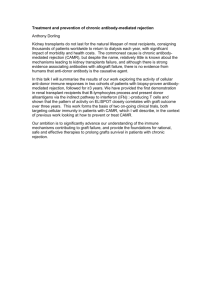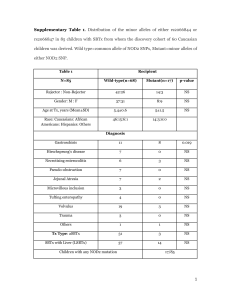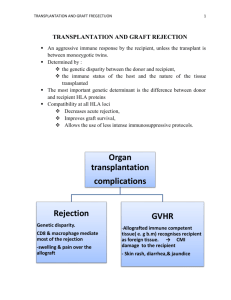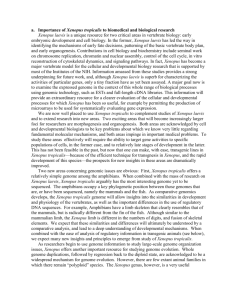Christina Rumsey, cr2100@columbia
advertisement
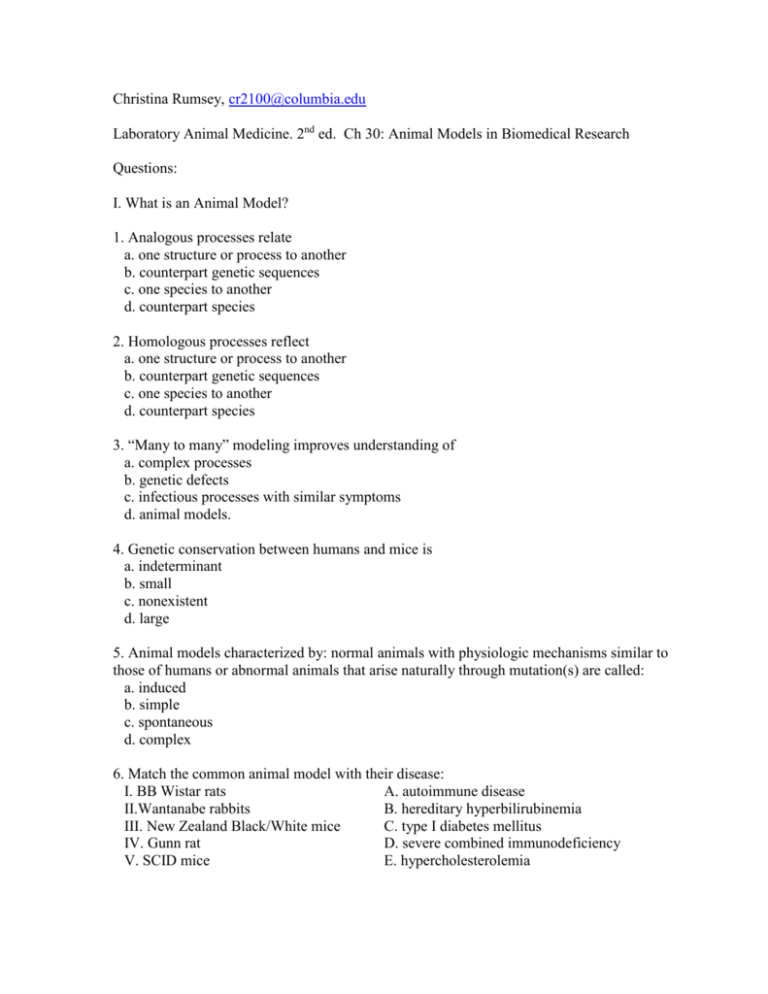
Christina Rumsey, cr2100@columbia.edu Laboratory Animal Medicine. 2nd ed. Ch 30: Animal Models in Biomedical Research Questions: I. What is an Animal Model? 1. Analogous processes relate a. one structure or process to another b. counterpart genetic sequences c. one species to another d. counterpart species 2. Homologous processes reflect a. one structure or process to another b. counterpart genetic sequences c. one species to another d. counterpart species 3. “Many to many” modeling improves understanding of a. complex processes b. genetic defects c. infectious processes with similar symptoms d. animal models. 4. Genetic conservation between humans and mice is a. indeterminant b. small c. nonexistent d. large 5. Animal models characterized by: normal animals with physiologic mechanisms similar to those of humans or abnormal animals that arise naturally through mutation(s) are called: a. induced b. simple c. spontaneous d. complex 6. Match the common animal model with their disease: I. BB Wistar rats A. autoimmune disease II.Wantanabe rabbits B. hereditary hyperbilirubinemia III. New Zealand Black/White mice C. type I diabetes mellitus IV. Gunn rat D. severe combined immunodeficiency V. SCID mice E. hypercholesterolemia 7. Combination of which two chemicals leads to destruction of the beta cells of the islets of Langerhans (choose 2 answers): a. beta polymerase b. alloxan c. streptozotcin d. MPTP 8. The scientific name of the African Clawed frog is: a. Xenopus embrus b. Xenopus laevis c. Xenopus rhodus d. Xenopus amphibis 9. The assay developed using the above frog embryos and larvae to document developmental abnormalities associated with environmental chemicals is called: a. amphibian abnormalities assay (3A) b. amphibian teratogenesis assay: Xenopus (ATAX) c. frog embryo abnormalities assay (FEAA) d. frog embryo teratogenesis assay: Xenopus (FETAX) 10. Oncornavirinae, Lentivirinae, and Spumavirinae are the three subfamilies of: a. retroviruses b. poxviruses c. parvoviruses d. paramyxoviruses 11. This subfamily of virus is known to infect and cause cancer in multiple species: a. parvovirinae b ocornavirinae c. spumavirinae d. lentivirinae 12. Perhaps the most important single feature of an animal model is: a. defined genetic condition and defined disease status b. economy of maintenance c. how closely it resembles the original human condition or process d. ease of handling 13. This species has been used extensively for studies in development because their embryos are transparent, each clutch contains 50-100 embryos, and they are amenable to large-scale mutagenesis: a. C57/Bl6 b. african clawed frogs c. zebrafish d. Mus musculis 14. Direct insertion of cloned genetic material into the pronucleus of a fertilized mouse egg results in a site of DNA integration that is: a. predictable b. random c. constant d. heritable 15. A variety of _________ have been developed to control the expression of transferred genes in transgenic animals. a. promoters b. chimera c. mutagens d. binders 16. After ____ brother x sister matings, offspring are considered an inbred strain. a. 10 b. 20 c. 30 d. 9 17. Mice cloned from embryonic stem cells rather than from the low-passage primary cell cultures used in the past show a. genetic variance b. phenotypic heterogeneity c. mitochondrial homogeneity d. mitochondiral heterogeneity 18. The nematode in which multiple induced mutations were found to extend life span is: a. Caenorhabditis elegans b. Saccharomyces cerevisiae c. Drosophila spp. d. Ancylostoma braziliense 19. Decrease in DNA telomere length and accumulation of extrachromasomal rDNA circles has been associated with a. increase in lifespan b. aging/decrease in lifespan c. increase in genetic mutations d. decreased cellular energy 20. Mutations for the gene for this protein have been found in human families with familial Alzheimer’s disease a. b-amyloid b. fibrillar aggregates c. amyloid precursor protein d. neurofibrillary tangles 21. True or False? There is a considerable degree of conservatism in the activity of products expressed from homologous genes between species. 22. Phenotype of genetically manipulated mice may vary with a. respect to human phenotype with the same mutation b. each individual c. background strain d. a and c II. The Nature of Research 23. He perceived the defects inherent in the scholastic method practiced before him and set the tenets for what would become hypothesis testing. a. Francis Bacon b. Issac Newton c. Coperuicus d. Galileo 24. The paradigm of generating a _________ based on known facts and designing experiments to disprove it has been proven over time to generally produce meaningful and reproducible results. a. abstract b. hypothesis c. discovery d. truth 25. True or False: few basic science discoveries are cited in seminal papers describing a clinical breakthrough? 26. Serendipity contributes to important discoveries: the cause of beriberi was discovered to be a deficiency of this vitamin after chickens fed polished boiled rice developed a similar condition. a. C b. A c. folate d. thiamin 27. This new discipline merges biology with mathematics, computer science, and engineering. a. genetics b. bioinformatics c. PCR d. transgenics 28. This method for predicting protein function looks for the correlation of protein inheritance across species. a. PCR b.transgenics c. phylogenetic profiling d. Rosetta stone method 29. This method for predicting protein function looks for correlation of protein domains across species. a. PCR b.transgenics c. phylogenetic profiling d. Rosetta stone method 30. True or False: comparing genomes of different species does not provide valuable information concerning noncoding regions in the DNA sequence. 31. This will become the standard model of the future, having the advantage of similar physiology, similar genomic structure, high fecundity, and ease of maintenance. a. mouse b. Drosophila c. rat d. human III. History of Animal Use in Biomedical Research 32. True scientific inquiry began in which country? a. Greece b. Italy c. Mesopotamia d. Egypt 33. During the Middle Ages until the Renaisance, the writings of these two ancient societies remained the final word on science and medicine: a. Greeks and Turks b. Greeks and Romans c. Romans and Egyptians d. Egyptians and Greeks 34. Pasteur developed the first vaccine against what disease? a. smallpox b. anthrax c. cholera d. rabies 35. Robert Koch developed what substance to identify infected animals and people? a. bacterial cultures b. serologic testing c. tuberculin d. antiseptic prevention of infection 36. The Austrian monk who used peas to demonstrate that specific traits are inherited in a predictable fashion was: a. Charles Darwin b. Gregor Mendel c. William Bateson d. Issac Newton 37. The three-dimensional helical structure of DNA was deduced by Crick & Watson in which decade? a. 1930s b. 1940s c. 1950s d. 1960s 38. Which technique allowed Crick & Watson to deduce the double helical structure of DNA? a. chemistry b. PCR techniques c. genetics d. x-ray diffraction 39. The organism that was amongst the first to have its entire genome sequenced was: a. E. coli b. yeast c. fruit fly: Drosophila melanogaster d. all of the above 40. The standard tuberculin skin test was one of the first demonstrations of a. humoral immunity b. cellular immunity c. phagocytic cellular activity d. antigen binding 41. Knowledge of what blood factor has allowed the treatment of erythroblastosis fetaliz (hemolytic disease of the newborn)? a. ABO blood group b. Rh factor c. MNP group d. platelets 42. The site of antibody-producing B cells in the chick is a. lymph nodes b. bursa of Fabricias c. bone marrow d. thymus 43. The concept that early antigen exposure prevents the immune system from recognizing the antigen later as foreign is referred to as a. immunosupression b. allograft rejection c. acquired immunological tolerance d. dizygotic acceptance 44. The genetic locus important in allograft rejection is referred to as a. major histocompatibility locus (MHC) b. immune response (IR) genes c. human leukocyte antigen (HLA) system d. allograft rejection section 45. This cell, discovered in the 1960s, was later found to mediate graft rejection, modulate antibody synthesis, and directly participate in the eradication of infectious agents and cancer: a. B cell b. leukocyte c. T cell d. rubricyte 46. Cells presenting MHC II molecules stimulate a. CD4 cells b. CD 8 cells c. B cells d. red blood cells 47. Cells presenting antigen together with MHC I molecules stimulate a. CD4 cells b. CD 8 cells c. B cells d. red blood cells 48. SCID mouse immunodeficiency is due to a mutation in which gene? a. rag1 b. lac c. gld d. 1pr 49. Acute allograft rejection is mediated by a. CD4 cells b. CD 8 cells c. B cells d. a & b 50. Apoptosis and immune tolerance are linked through the activation of immuno-regulatory mechanisms mediated by a. CD4 cells b. CD 8 cells c. inhibitory cytokines d. B cells 51. Based on new immunologic knowledge, experimental applications of vaccines are also being developed for a. autoimmune diseases b. prevention of graft rejection c. cancer d. a & c 52. Genotyping family members at risk to identify candidates for disease before symptoms and using certain autoantigens, when delivered by oral route, to induce tolerance are strategies developed to combat a. autoimmune diseases b. prevention of graft rejection c. cancer d. tropical diseases 53. Levamisole, developed as a cattle wormer, is now used together with 5-fluorouracil in the treatment of a. autoimmune diseases b. prevention of graft rejection c. colon cancer d. onchocerciasis (river blindness) 54. Ivermectin, developed as a preventative for heartworm disease in dogs, is now being used to treat people for a. autoimmune diseases b. prevention of graft rejection c. colon cancer d. onchocerciasis (river blindness) Answers: 1. a 2. b 3. a 4. d 5. c 6. I. c, II. e, III. a, IV. b, V. d 7. b & c 8. b 9. d 10. a 11. b 12. c 13. c 14. b 15. a 16. b 17. d 18. a 19. b 20. c 21. True 22. d 23. a 24. b 25. T 26. d 27. b 28. c 29. d 30. False 31. a 32. a 33. b 34. d 35. c 36. b 37. c 38. d 39. d 40. b 41. b 42. b 43. c 44. a 45. c 46. a 47. b 48. a 49. d 50. c 51. d 52. a 53. c 54. d

